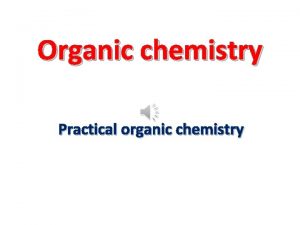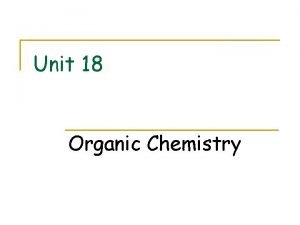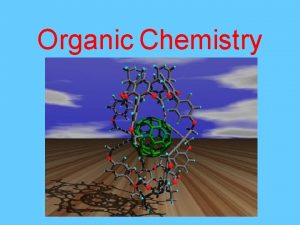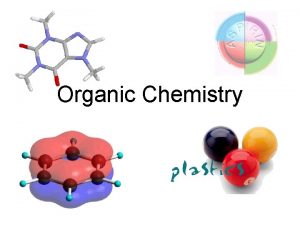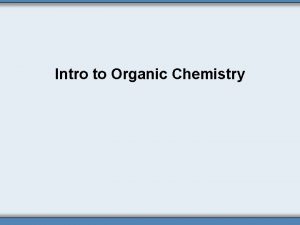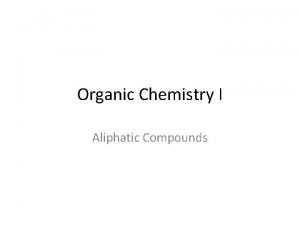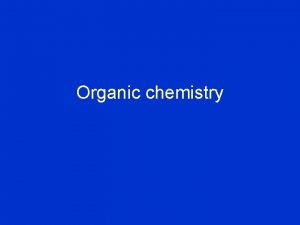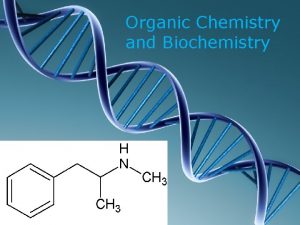ORGANIC CHEMISTRY UNIT 3 Organic chemistry is defined






















- Slides: 22

ORGANIC CHEMISTRY UNIT 3

¡ Organic chemistry is defined as the study of compounds in which carbon is the principle element. Organic compounds always contain a combination of carbon and hydrogen. They may also contain oxygen and nitrogen.

¡ Hydrocarbons are a group of organic compounds that only contain carbon and hydrogen.

¡ Organic compounds are held together by covalent bonds. ¡ Every carbon atom will have FOUR lines around it but these lines will not always be single lines. This is because carbon atoms don’t always form single covalent bonds. Double or triple bonds can form between the carbon atoms.

¡ Hydrocarbons are classified into three different groups according to whether the molecules contain only single bonds between the carbon atoms, or some double or triple bonds between the carbon atoms.

¡ Alkanes are hydrocarbons that contain only single bonds between the carbon atoms. The general formula for an alkane is Cn. H 2 n + 2.

¡ Alkenes are hydrocarbons that contain at least one carbon to carbon double bond in the molecules. The general formula for an alkene with one double bond in the molecule is Cn. H 2 n.

¡ Alkynes are hydrocarbons that contain at least one carbon to carbon triple bond in the molecule. The general formula for an alkyne with one triple bond in the molecule is Cn. H 2 n-2.

Naming hydrocarbons ¡ The systematic name of hydrocarbons will have two parts. The first part of the name indicates the number of carbon atoms in the chain. The ending of each name indicates the type of hydrocarbon. - ane – alkane – all single bonds - ene – alkene – at least one double bond - yne – alkyne – at least one triple bond

These prefixes must be memorized.

Example 1: 1. Propane is a fuel that is commonly used in gas barbecues. Draw a structural formula for propane, and write its formula.

2. Butane, commonly used in lighters, contains a four-carbon chain joined by single bonds.

3. Octane, found in gasoline, contains an eight-carbon chain joined by single bonds.

4. Methane, the natural gas that is used in homes and school science labs, is a single carbon atom with four hydrogen atoms.

Drawing Structural Formulas for Alkenes and Alkynes ¡ Draw a structural formula and write the molecular formula for 1 -hexene. l l Step 1: Write Carbon Backbone of Appropriate Length Start with the name “hexene. ” The hextells you that there are six C atoms in a chain.

Draw a structural formula and write the molecular formula for 1 hexene ¡ Step 2: Establish Location of Double Bond l l l The -ene tells you that there is a double bond linking two of the C atoms The number at the beginning of the name tells you which C atom starts the double bond. Since the alkene is 1 -hexene, the double bond starts at the first C atom and ends at the second C atom.

Draw a structural formula and write the molecular formula for 1 hexene ¡ ¡ Step 3: Fill Remaining Bonds with Hydrogen Atoms There are 6 C atoms and 12 H atoms in total, so the molecular formula is C 6 H 12

Write the IUPAC name and the molecular formula for each of the following alkenes:


Draw a structural formula and write the molecular formula for each of the following hydrocarbons: ¡ (a) ethene ¡ (b) ethyne ¡ (c) 2 -hexene


Assignment Page 183 1 and 2 ¡ Page 190 1 and 2 ¡
 Ib organic chemistry functional groups
Ib organic chemistry functional groups Inorganic vs organic chemistry
Inorganic vs organic chemistry Collection of well-defined objects
Collection of well-defined objects Cycloalkanes
Cycloalkanes Soap organic chemistry
Soap organic chemistry Ester organic chemistry
Ester organic chemistry Prop but pent hex hept oct
Prop but pent hex hept oct Rearranged most stable carbocation is
Rearranged most stable carbocation is Ee organic chemistry
Ee organic chemistry Leveling effect organic chemistry
Leveling effect organic chemistry Organic chemistry (3rd) edition chapter 1 problem 16s
Organic chemistry (3rd) edition chapter 1 problem 16s David klein organic chemistry
David klein organic chemistry Organic chemistry 2nd edition klein
Organic chemistry 2nd edition klein What is the leveling effect organic chemistry
What is the leveling effect organic chemistry What does n mean in nomenclature
What does n mean in nomenclature Objective lab report example
Objective lab report example Organic chemistry conversion chart
Organic chemistry conversion chart Grade 10 organic chemistry
Grade 10 organic chemistry Organic chemistry
Organic chemistry Organic chemistry introduction
Organic chemistry introduction Kiliani fischer synthesis
Kiliani fischer synthesis Pent hex hept oct
Pent hex hept oct Alkane cracking
Alkane cracking






























